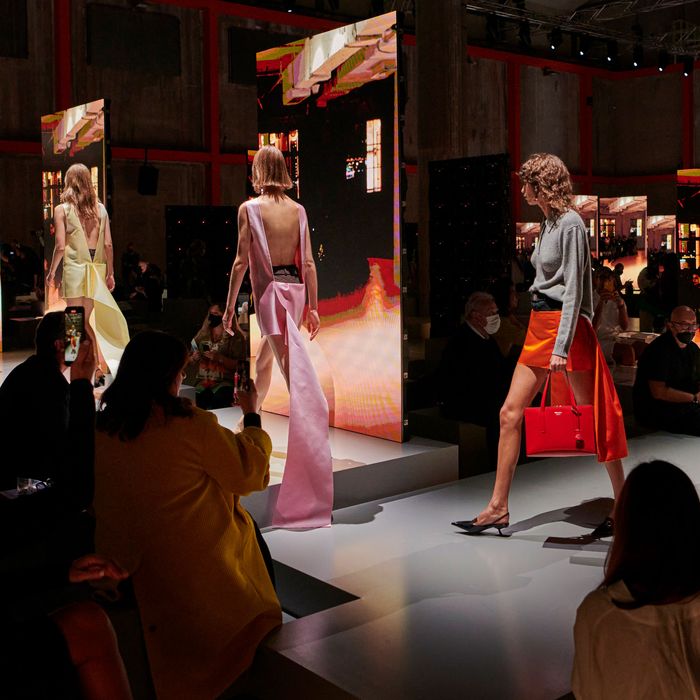
“After all that has happened, how can you just go back?” Miuccia Prada asked. That remark might seem puzzling, even disingenuous, given the scope of the Prada show on Friday. It was actually two shows in one: a runway presentation at the Prada Foundation in Milan, and a duplicate in Shanghai, connected by technology and shown on monitors. The whole thing must have cost millions.
Prada not back? As for the collection, it seemed the ideal visual reward after a tumultuous time: a big, unambiguous, Prada-size dose of fashion.
But the comment is actually typical of her. As her creative partner, Raf Simons, once told me, “Miuccia questions everything.”
Let’s consider how that questioning played out in this smart collection, and why, perhaps more than ever, it separates Prada from its peers. The show space, a cavernous industrial building in the middle of a sprawling complex, featured wooden boxes of various heights, which had been uniformly painted gray. Embedded in some boxes and columns were digital screens, and near them, taller flat screens. Snaking around them, almost like an urban highway, was the runway, also gray. Indeed, the set seemed an abstraction of an architectural model of a city, or a city seen in a video game. Before the show started, the image on the screens was of night-time, neon-glowing Shanghai.
During the early phase of the pandemic, European brands realized they had to depend on technology in order to monitor their global businesses, as well as their fragile supply chains. But, for many luxury brands, it was China that saved their bacon. One Italian CEO told me the other day that while his sales are down about 40 percent — mainly because of the absence of tourists in Europe — his numbers are up in China. Other companies have reported a similar reality.
So linking Milan and Shanghai was a powerful gesture. Many of the shows here have felt frankly insular, in the old Italian manner — the same huge runways, the same branding motifs. They do seem as determined as ostriches to get back to the way things were before. Look at the Versace collection. Staged last night on a long runway in the subterranean Milano Mall, it featured shirtless male models pulling ropes that caused a printed silk canopy to flutter — I guess like a tent in the desert. The clothes, which included oversized hoodies, flowing silk pajamas, and a new rendition of Gianni Versace’s now classic safety-pin punk dresses, will no doubt look good in stores next spring. But that’s because they were mostly designed to a formula. Where was the imaginative leap forward? The tiniest acknowledgement that the world has changed?
It is, admittedly, difficult for super brands to change direction. Yet that is why the Prada show was so enervating. Simons and Prada also embraced sexy clothes — a big theme of the New York collections, to the point of near nakedness. And after a year of sweatpants, after little or no physical contact, it was inevitable that clothing would be more revealing.
But Prada and Simons did it with great consideration. They stayed high when almost everyone else has gone low. Every gesture in the collection can be traced to Simons or Prada’s aesthetic or personal obsession. The abundance of duchess satin for skirts with flippy, abbreviated trains? Both designers love couture. The reduction of the trains aligns with Simons’s favorite form, minimalism. Prada has always loved a skirt and a plain, cozy sweater — hence the number of satin mini skirts that appeared with almost ordinary looking sweaters and a pair of sling-backs.
Sexy isn’t all that interesting. Seduction is, however, and that’s what the designers were after, notably with chic, below-the-knee dresses in black, pink, and neon yellow (also a lovely shade of flesh pink, in cotton, that looked almost tea-stained) with a lightly gathered waist and the back buttons left mostly unbuttoned to reveal a taut belt and of course a lot of bare skin. There were also a couple of boned jackets in off-white or pale pink cotton-linen blend that suggested at once a corset and the muslin traditionally used by couturiers to make their first samples. But where a corset constricts the body, these pieces were the opposite — relaxed.
That was another clue. Prada and Simons smartly tempered the couture elements and the seduction with practical dressing, like the fantastic, slightly distressed leather jackets and car coats that accompanied many of those foxy train skirts. The designers were not giving interviews this season or greeting guests backstage, because of COVID protocols, but I happened to run into Simons in the foundation courtyard, and he said that he and Prada wanted to offset “the couture with an everyday sense.”
That’s just one small but important reason that this collection felt substantial, a true jolt of high fashion and not a business-as-usual spree of salable clothes.
Two other collections, though smaller in aim, deserve mentioning: Sportmax and Aspesi. Lawrence Steele, who has a long track record in Milan — he worked as a designer at Prada for many years and then started his own label—is now the creative director at Aspesi, a beloved brand that goes back to the late 1960s. The Aspesi look was always Milanese casual — meaning, great shirts, quirky knits, and relaxed masculine tailoring — and Steele’s goal is to bring it to a wider audience, now that the company is owned by a Roman conglomerate, with wealth from other industries like shipping. The clothes, priced at about 30 percent below designer, are right in a comfortable, genderless vibe.
The photographer Vanina Sorrenti did the imagery, and Camilla Nickerson the styling, for the collection, which included tweed pantsuits, old-school sweater vests, and a 1920s inspired floral print for a long slip dress, while the modeling was done by, among others, Nickerson’s son Atticus Wakefield, and Joey Borthwick, the son of the photographer Mark Borthwick and designer Maria Cornejo. So the family feeling is no accident.
Although modern dance and music were the guiding source for Sportmax — namely, the work of the Americans John Cage and Merce Cunningham — I was simply charmed by the lightness and deliberately messy romance of the collection, much of it in ultra-feminine fabrics like white gauze and georgette. There were also fragments of corsets in some of the deconstructed dresses and coats, a nice nod to the past. In Europe, the past is always with you. The surprise to me — away from Milan these past seven years — is how realistically experimental and free Sportmax has become.
More From Milan Fashion Week
https://ift.tt/3i6NM7G
Fashion
Bagikan Berita Ini
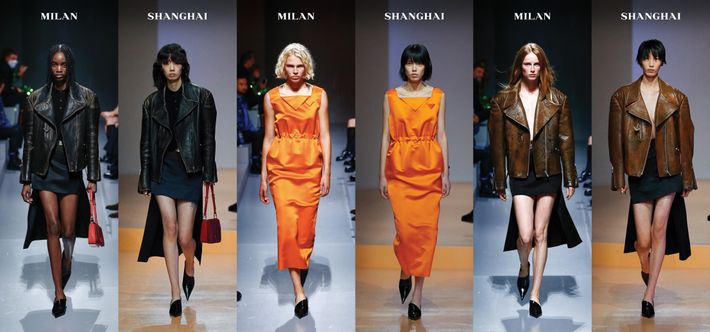
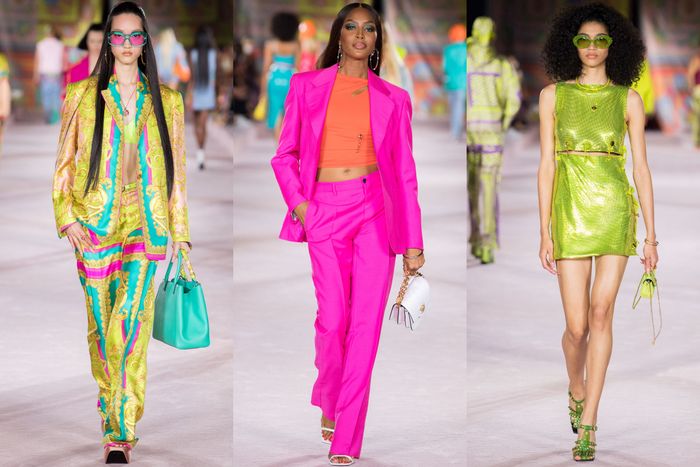
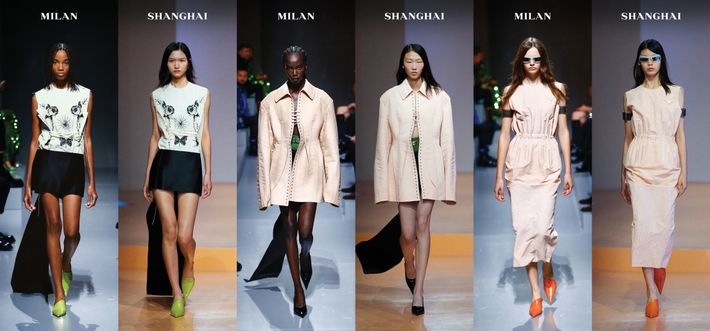
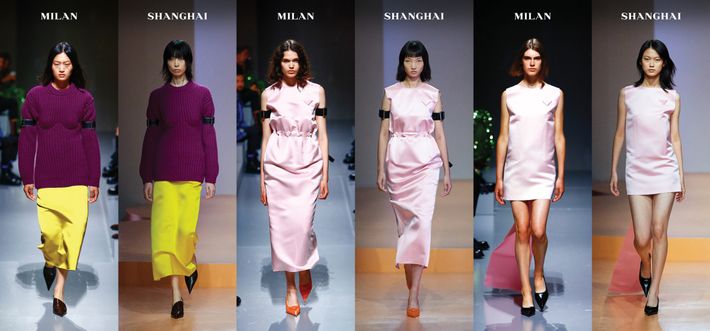
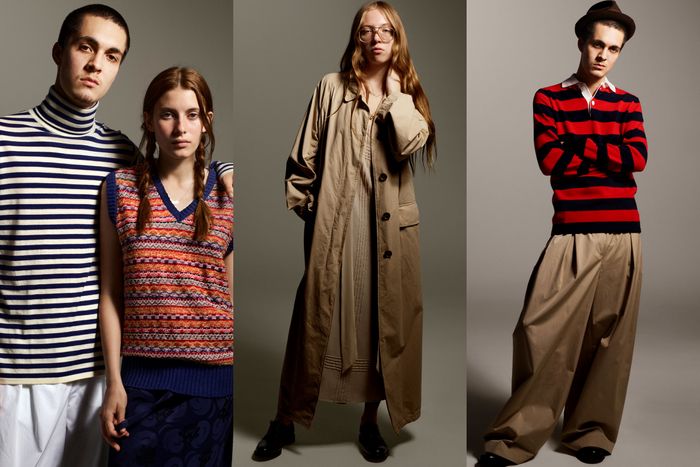
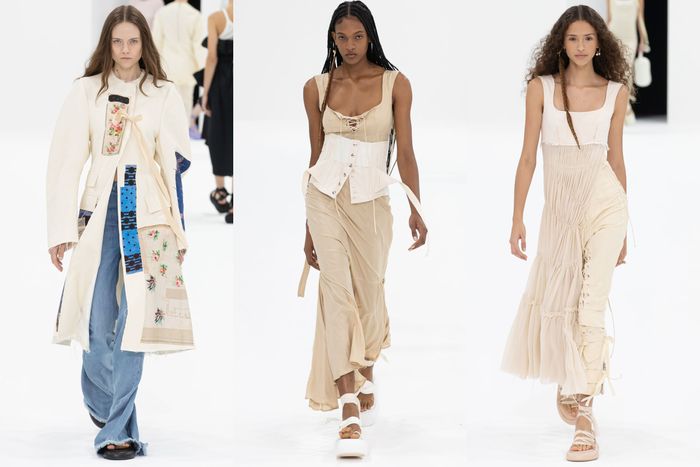














0 Response to "At Milan Fashion Week, Prada Seduces - The Cut"
Post a Comment